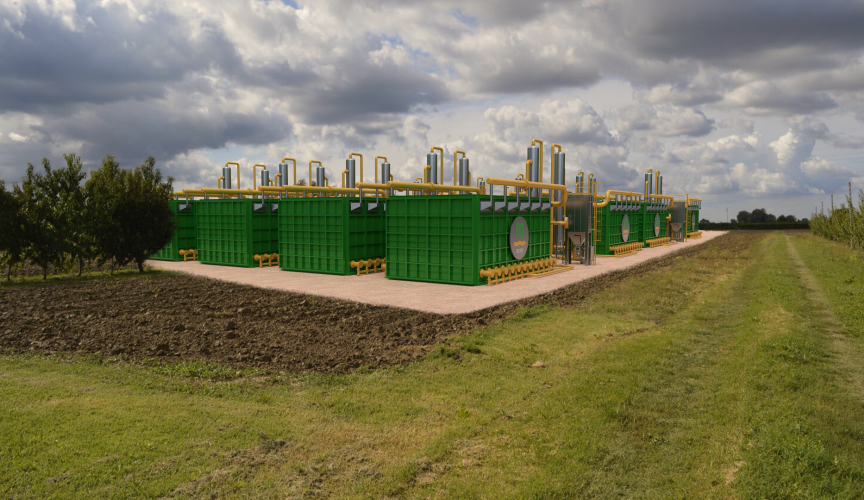
by Massimiliano Masi, General Manager of Magaldi Green Energy Middle East
Energy transition and energy resilience cannot be achieved without two fundamental parameters, not only for Italy but for Europe as a whole:
- the actual availability of natural resources - wind, sun, and earth
- trusted relationships and strategic agreements with other countries
Since the Second World War, the industrial development has been based on oil and derivatives (only later on gas), resulting in the formation of a producer-versus-consumer bloc.
Through the various oil crises, price volatility and rationing of raw materials availability, consumer countries have over time developed various strategies to free themselves from dependence on producer countries: first of all they have looked for alternative solutions to oil.
The decline in popularity of nuclear fission as a result of the catastrophic events of Chernobyl (1986) and Fukushima (2011), as well as the very high security standards required for these technologies - which have frequently proven uneconomical also for decommissioning costs -, have pushed Western advanced economies - since the 2000s - to accelerate planning efforts for energy independence from fossil sources, primarily based on the production of electricity from sun and wind.
Learning curves, financial incentives and economies of scale have led to a cost reduction of 90% in about 20 years, enabling progress from projects of a few MW to projects of GW (1000X scale). Furthermore, the availability of large photovoltaic and wind farms (utility scale, i.e. from 100 MW to 2-3 GW) has opened a new technological frontier: the production of green hydrogen to replace fossil fuels.
Nonetheless, large fields of renewable energy can be stationary and unproductive since wind and sun are intermittent sources of uncertain availability, as opposed to fossil fuels that can be burnt anytime to generate 24/7/365 energy.
In the last 3-5 years, green hydrogen has certainly assumed the role of champion of the energy transition. It has indeed been perceived as the "renewable fuel" as it represents a strategy for storing renewable energy in hydrogen and oxygen, thus ensuring continuous energy availability.
The megatrend of decarbonisation to reduce CO2 emissions and the rise in temperatures, has in fact triggered a long-term vision based on the hydrogen economy.
But, are we certain that green hydrogen is a universal solution for replacing fossil fuels? Energy strategies must deal with actual politics: whether it is desirable to invest in collaboration with nations that have the natural resources to create huge amounts of green energy, or whether it is preferable to pursue energy independence at any cost.
The main issue is that the economical production of green hydrogen requires GW of renewable energy totally dedicated to the electrolysers and, consequently, an extremely large space of land or marine areas, in addition to a consistent amount of solar irradiation and constant wind.
In Western countries - that have committed to reach "Net Zero Economies" by 2050 -, these land-intensive settlements must be added to those already planned to produce electricity in line with the decarbonisation goals.
On average, a solar 1 GW field requires a land availability of about 16 km2 (a 4 Km x 4 Km area), which is almost never free unless you go and settle it in large, flat agricultural areas.
In Europe, onshore areas are not free from agricultural settlements, and no State will accept to change their agro-food vocation. Utility Scale plants can be quickly built only in those countries of the world where there are abundant lands which have not been used for urban, agricultural or industrial purposes.
This situation invites us to imagine potential co-investments of European countries in North African neighboring countries - current strategic suppliers of gas to Europe - to produce green hydrogen locally through mega-plants established in desert areas, to then transporting this precious fuel through new pipelines or packed into tankers.
Although a "technical" bankability for such a policy can be found, the fundamental question is still to be solved: can Europe trust this strategy? After years of dependence on fossil fuel-producing countries - at the mercy of geopolitical tensions which have often transformed into bloody and unpredictable conflicts – is EU willing to take the same risk (which has cyclically become a real energy crisis for oil and gas) for the next 100 years?
We must bear in mind that green hydrogen-producing countries will have every interest in selling it without stopping supplies. Let’s figure out what would it mean in terms of price and geopolitical scenarios, including warfare. Under this scenario, how much importance could have the “Net Zero” targets if the risks of conflicts will not decrease, rather they might increase for accessing the green hydrogen?
Analogies with the terrible events in Ukraine over the recent months and price increase in oil and gas leave no doubt about a strong and decisive conclusion for the immediate implementation of energy strategies: State’s energy systems must be based on maximum control of national sources and on solidarity with allied countries.
Nevertheless, in 2022 we are still far from a situation similar to that of the United States: European countries will still need many years of work to reach an effective joint energy purpose. Unfortunately, the implication is that every State and, consequently, every industry willing to stop depending on third parties’ sources must largely rely on its own national “renewable” sources.
What is truly required is the integration of various renewable technologies to provide continuous electrical and thermal services. The key is not to get hydrogen, but to supply it directly - and locally - to industrial production sectors.
Furthermore, it is essential to create and strengthen long-term collaborative mechanisms with international partners with whom it is possible to establish strategic agreements of mutual interest.
A real example? The Magaldi Green Thermal Energy Storage - MGTES – system, produced by Magaldi Green Energy.
Providing that any country, Italy in the first place, cannot avail itself on a single “Holy Grail” to achieve energy independence, the question is what could be the real long-term policies towards green energy independence?
Here is a list of some enabling proposals:
- installation of "large" solar plants and offshore wind farms through structural agreements with agriculture associations/owners or in dedicated requalification of abandoned industrial sites
- creation of storage hubs - combining electrochemical batteries with thermal storage
- decentralization of electricity production through the (incentivized) obligation to install solar panels on every suitable rooftop
- incentives for Power to Heat: excess production from renewable energy transformed into heat available for industrial districts; district heating and urban cooling
- creation of green hydrogen islands near large renewable plants
- building and consolidation of long-term, trusted relations of mutual interest with countries producers of green hydrogen and with high-level political and strategic stability, such as the Gulf countries (UAE, KSA)
As Magaldi Green Energy we are working to produce the best thermal storage solution to be the perfect, complementary substitute for gas and fossil fuels. The first target is aimed at industrial applications, based on the storage of electrical and thermal energy in a fluidized bed of sillica sand. A simple and extraordinarily efficient solution to store significant amounts of green heat at high temperatures to secure the availability of thermal (and possibly electrical) energy when needed, without burning any fossil fuel.
In addition, MGTES is designed with simple and long-life materials. The product life-cycle is 30+ years with minimum maintenance, making of our technology a real energy infrastructure for the country just alongside power plants, power grids and gas.
Given its very long-term utility, MGTES thermal storage represents an infrastructural asset of high interest for any country which aims to pursue a policy pathway towards an independent energy transition.



